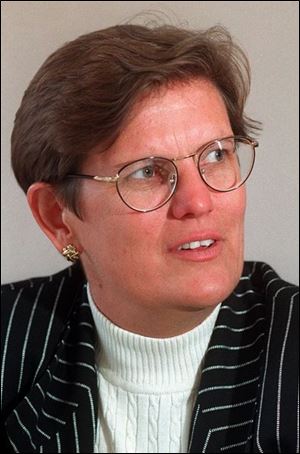
Women led the way with lots of firsts
3/2/2003
Kathryn Sullivan was the first American woman to walk in space.
Ohio would be a lot different today if women had not stretched their traditional boundaries, finding their places in community service, social activism, religion, arts and music, journalism, sports, medicine, education, business, government, law, and science.
Ohio can claim the first American woman to walk in space (Kathryn Sullivan, 1984); the first woman to run for president (Victoria Claflin Woodhull, 1872); the first woman political cartoonist (Edwina Dumm, 1915); the first woman to fly solo around the world (Jerrie Mock, 1964), and many more.
Florence Allen was the first woman in the United States to be elected to a judgeship (1920, Common Pleas Court in Cleveland). In 1921, she became the first woman judge to sentence a man to death. She later served on the Ohio Supreme Court — another national first — and was appointed by President Franklin Delano Roosevelt in 1934 to the 6th Circuit Court of Appeals in Cincinnati.
Cleveland's Donna Shalala was confirmed as U.S. Secretary of Health and Human Services in 1993. The next year, Mary Ellen Withrow of Marion County became treasurer of the United States, the first person to serve as treasurer at the county, state, and national levels.
Dolly Spencer of Milford was the first woman in the nation to serve as chief of police (1914).
The Ohio Women's Hall of Fame, established in 1978, has recognized more than 300 such women. The Ohio Bicentennial Commission is erecting markers honoring 10 women around the state — none in northwest Ohio — starting Tuesday in Urbancrest with a tribute to Ellen Walker Craig-Jones, who in 1972 became the first African-American woman elected mayor by popular vote of a U.S. municipality.
“In my opinion, Ohio's women have played a much more important role over the last several hundred years than they are given credit for in the history books,” said Michael Drew Shaw, a Toledo broadcaster and filmmaker who has produced an audio CD on state history titled “Ohio, A Sentimental Journey.”
“Even the wives of our presidents pretty much stand in the shadows,” he added, “with a few exceptions like Rutherford Birchard Hayes' wife, Lucy Webb — the first woman to be called the First Lady — who started the annual White House Easter egg roll.”
His CD mentions numerous notable Ohio women, among them feminist Gloria Steinem (Toledo); performer and marksman Annie Oakley (Patterson); “Wicked Witch of the West” Margaret Hamilton (Cleveland); and singers Teresa Brewer (Toledo), Maureen McGovern (Youngstown), Nancy Wilson (Chillicothe), Anita Baker (Toledo), and the McGuire Sisters (Middletown). It notes that Athens native Maya Lin designed the Vietnam Veterans Memorial and that astronaut Judith Resnick of Akron was among those lost in the 1986 Challenger disaster.
Ohio women were political even before they got the right to vote, observed Dr. Susan Hartmann, professor of history at Ohio State University.
“Women actually created the early social welfare institutions which are now typically run by government,” she said, including hospitals for women and children, orphanages, and homes for unwed women. She said they also campaigned for public parks and libraries. “Women tended to get involved in suffrage as a result of being interested in social reform.”
Buckeye women were ahead of their sisters in many other states in entering the public arena, drawn to activism by the anti-slavery movement. Harriet Beecher Stowe, who lived in Cincinnati for a time, published Uncle Tom's Cabin in 1852, converting readers around the world to the cause of abolition.
Ohioans also were in the front lines of the war on alcohol. “Ohio women led this nationwide crusade for temperance,” wrote Stephane Elise Booth in Buckeye Women: The History of Ohio's Daughters. On Dec. 24, 1873, Eliza Jane Trimble Thompson led about 75 women from saloon to saloon in Hillsboro, Ohio, singing, praying, and demanding that barkeepers sign a pledge not to serve alcohol.
Dr. Booth, Kent State University's interim dean for academic and student services at regional campuses, said that women were not directly involved in the Ohio statehood movement. Their role then was in “civilizing” the new land, she said — working behind the scenes to organize schools, churches, and literary societies, for example.
“The quality of life of the people of Ohio has always been in the hands of women,” she said. They were typical of the countless “ordinary” women who have had a hand in history.
“Women's history is a part of social history,” agreed Kathy Hoke, a PhD candidate in women's history at OSU and spokesman for the Ohio Historical Society.
“By studying women and their roles in families, workplaces, and communities, historians have helped us understand how our culture has changed over time and how ordinary people contributed to our past and present.”